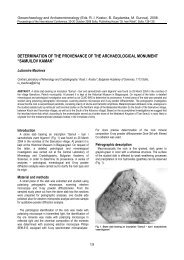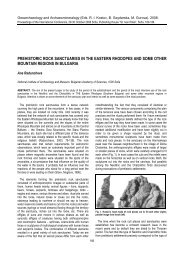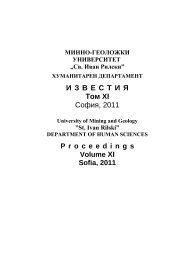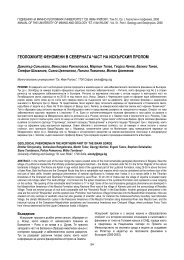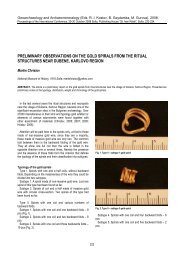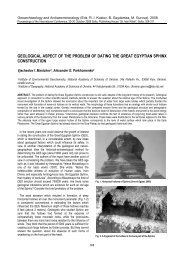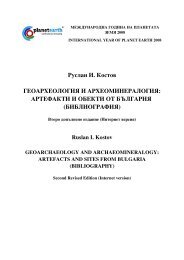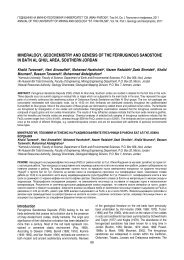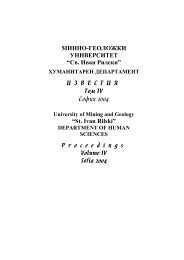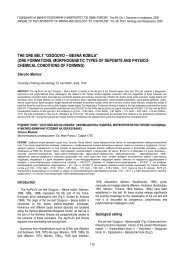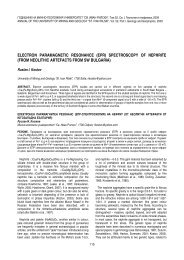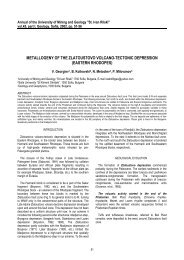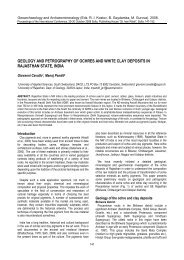archaeological evidence for the exploitation of gold ore deposits at ...
archaeological evidence for the exploitation of gold ore deposits at ...
archaeological evidence for the exploitation of gold ore deposits at ...
You also want an ePaper? Increase the reach of your titles
YUMPU automatically turns print PDFs into web optimized ePapers that Google loves.
On <strong>the</strong> base <strong>of</strong> <strong>the</strong> published sources <strong>the</strong> conclusion can<br />
be drawn th<strong>at</strong> <strong>for</strong> most known examples one can speak only <strong>of</strong><br />
ancient <strong>gold</strong> mining without having d<strong>at</strong>a allowing chronological<br />
decisions to be done from <strong>the</strong>se findings. Only in certain cases<br />
<strong>the</strong> <strong>archaeological</strong> chance has made possible discovery <strong>of</strong><br />
m<strong>at</strong>erials allowing m<strong>ore</strong> precise d<strong>at</strong>ing. Such are <strong>the</strong> cases<br />
with <strong>the</strong> antique mines <strong>of</strong> Kolio Marinovo (Sarnena Gora<br />
Mountain) and Babyak (Western Rhodopes) which are <strong>the</strong><br />
object <strong>of</strong> our study. The <strong>evidence</strong>s refer mainly to Roman and<br />
Medieval Ages although <strong>the</strong>re are many indic<strong>at</strong>ions th<strong>at</strong> <strong>the</strong>se<br />
<strong>deposits</strong> were known in earlier periods. These suggestions are<br />
a result <strong>of</strong> a thorough study <strong>of</strong> <strong>the</strong> settlement system from <strong>the</strong><br />
territory <strong>of</strong> <strong>the</strong> recorded ancient mining <strong>exploit<strong>at</strong>ion</strong>s. The field<br />
observ<strong>at</strong>ions combined with studies on adjacent sites, certain<br />
historical facts and analyses <strong>of</strong> specialists from earth sciences<br />
Fig. 2. Map <strong>of</strong> <strong>the</strong> <strong>gold</strong> <strong>deposits</strong> from <strong>the</strong> territory <strong>of</strong> Bulgaria<br />
Mining galleries were discovered in <strong>the</strong> frames <strong>of</strong> <strong>the</strong> present<br />
village Kolio Marinovo which were described by Balaschev<br />
and Radoslavov. Coins minted in Serdicae between 197 and<br />
218 were found in <strong>the</strong>se galleries (Balaschev, 1922, 461-466;<br />
Radoslavov, 1934). This d<strong>at</strong>e serves as terminus ante quem,<br />
i.e. <strong>the</strong> galleries were surely exploited be<strong>for</strong>e this time<br />
(Tonkova, 2000, 137-138). At <strong>the</strong> same time, i.e. during <strong>the</strong><br />
Roman period <strong>the</strong>re was a <strong>for</strong>tress (quadriburgium, <strong>for</strong>tress<br />
with military functions, connected with <strong>the</strong> defense <strong>of</strong> roads or<br />
passes) (Dinchev, 1997, 95-96), obviously defending <strong>the</strong><br />
functioning mines. It must be noted th<strong>at</strong> just to <strong>the</strong> village <strong>of</strong><br />
Kolio Marinovo <strong>the</strong>re was an important Thracian sanctuary <strong>of</strong><br />
Kybele and <strong>the</strong> Thracian Heros (Velkov, 1932/34, 65) 1 – <strong>the</strong><br />
<strong>gold</strong> extraction was guarded both by <strong>the</strong> authority and by <strong>the</strong><br />
deities. The <strong>evidence</strong> in this respect are already plentiful th<strong>at</strong><br />
will be discussed bellow.<br />
1 During <strong>the</strong> field inspections a part <strong>of</strong> a votive tablet <strong>of</strong> <strong>the</strong> Thracian<br />
Heros was found; unpublished d<strong>at</strong>a <strong>of</strong> <strong>the</strong> author.<br />
267<br />
sometimes lead to very encouraging results. Some <strong>of</strong> <strong>the</strong>m will<br />
be presented bellow.<br />
The settlement system in <strong>the</strong> region <strong>of</strong> <strong>the</strong><br />
Chirpan Heights from <strong>the</strong> V-I c. BC and <strong>gold</strong><br />
extraction in Sarnena Gora in Antiquity<br />
One <strong>of</strong> <strong>the</strong> <strong>gold</strong>-bearing occurrences is loc<strong>at</strong>ed in <strong>the</strong><br />
South part <strong>of</strong> Sarnena Gora Mountain in <strong>the</strong> area <strong>of</strong> <strong>the</strong><br />
villages Chekhlare, Kolio Marinovo, Slavjanin and Gorno Selo.<br />
There was a claim <strong>for</strong> <strong>gold</strong> extraction <strong>at</strong> <strong>the</strong> mine ‘Golden<br />
Fleece’ in <strong>the</strong> 20-es <strong>of</strong> <strong>the</strong> last century. Gold has been still<br />
panned in <strong>the</strong> Rakhmanlijska, Omourovska and Novoselska<br />
Rivers till now (Fig. 2). There are clear <strong>evidence</strong>s <strong>for</strong> <strong>gold</strong><br />
extraction in this region in antiquity.<br />
There are indirect d<strong>at</strong>a about <strong>the</strong> <strong>exploit<strong>at</strong>ion</strong> <strong>of</strong> mines in<br />
Kolio Marinovo in Pre-Roman times. In this respect quite<br />
meaningful is <strong>the</strong> concentr<strong>at</strong>ion <strong>of</strong> hoards with coins <strong>of</strong> <strong>the</strong><br />
second and I c. BC from <strong>the</strong> lands <strong>of</strong> five neighboring villages<br />
in <strong>the</strong> <strong>gold</strong>-bearing zone: Chekhlare, Kolio Marinovo<br />
(Zl<strong>at</strong>areva, 1960), Pravoslav, Medovo (Gerasimov, 1963;<br />
Nikolov, 1964) and Naidenovo (Gerasimov, 1955) (Fig. 3).<br />
Their burial in <strong>the</strong> l<strong>at</strong>e I c. BC must has been connected with a<br />
probable instability in <strong>the</strong> region (Nikolov, 1964) th<strong>at</strong> could be<br />
referred to <strong>the</strong> control above <strong>the</strong> mines. Fur<strong>the</strong>rm<strong>ore</strong>, Y.<br />
Yuroukova supposes th<strong>at</strong> <strong>the</strong>ir burial was connected exactly<br />
with <strong>the</strong> <strong>of</strong>fensive <strong>of</strong> <strong>the</strong> army <strong>of</strong> <strong>the</strong> Roman commander<br />
Lucullus, suppressed <strong>the</strong> revolted against <strong>the</strong> Roman<br />
expansion Pontic colonies. It is considered th<strong>at</strong> Lucullus<br />
subjected <strong>the</strong> <strong>exploit<strong>at</strong>ion</strong> <strong>of</strong> <strong>gold</strong> from <strong>the</strong> mines <strong>at</strong> Kolio<br />
Marinovo and, even, with this <strong>gold</strong> he minted coins necessary<br />
<strong>for</strong> <strong>the</strong> replenishment <strong>of</strong> his treasury (Yuroukova, 1963, 43).<br />
The <strong>exploit<strong>at</strong>ion</strong> <strong>of</strong> <strong>the</strong> <strong>gold</strong>bearing deposit <strong>at</strong> Kolio Marinovo<br />
and <strong>the</strong> surrounding area <strong>of</strong> <strong>the</strong> Sarnena Gora in <strong>the</strong> earlier<br />
Classical and Hellenistic Ages can not be illustr<strong>at</strong>ed with such



